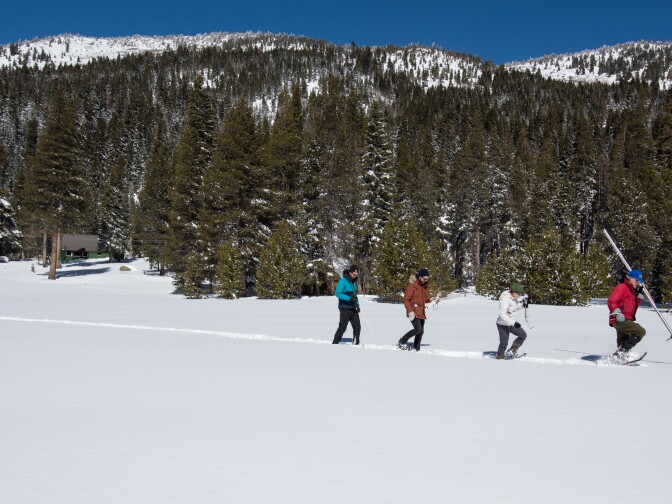Truth matters. Community matters. Your support makes both possible. LAist is one of the few places where news remains independent and free from political and corporate influence. Stand up for truth and for LAist. Make your year-end tax-deductible gift now.
This archival content was originally written for and published on KPCC.org. Keep in mind that links and images may no longer work — and references may be outdated.
California was in for one of the driest winters on record. Then March happened
Heavy rain and snow is in the forecast for California this week including local areas that are at risk of mudslides because of recent wildfires.
But there is an upside. All that precipitation is chipping away at a snowpack deficit in the Sierra Nevada mountains – the source of one-third of the state’s drinking water supply. December, January and February were unusually hot and dry. But March has been a different story. Since the beginning of the month, the Sierra snowpack has gone from 23 percent to 48 percent of average in terms of its snow to water equivalent. And more snow is on the way.
[Get the latest storm news: Powerful storm hits SoCal, triggering evacuations]
That has many wondering if we might be in store for another "March Miracle" of 1991. That winter started out just like this one, but saw upwards of 20 feet of snow in some places in a single month.
The outlook at the end of this February was nothing if not bleak.
"When we're talking February ... we're kind of in the same territory as 2015 or 1977, which are two of the most historic drought years on record," said Dave Rizzardo, chief of the snow survey section at the state Department of Water Resources. "It's a big deal."
Locally, things weren't much better. Downtown Los Angeles had only received 17 percent of average rainfall, while Santa Barbara and Ventura counties, which rely heavily on local water sources, had received less than 25 percent of their historic average. Much of those areas, which never fully recovered from the drought, slipped deeper into a chronic water deficit.
Then March happened. A series of storms brought both rain and snow to the state, raising the snowpack to 48 percent of where it should be by this time of year. And Santa Barbara and Ventura counties saw above average rain for the month in some areas.

"It's a lot better than it was," said Rizzardo. "We're at least getting into a territory we can consider it below average as opposed to critically dry."
But the month hasn't earned the March Miracle moniker just yet. To match the impact of the March 1991 deluge, California would have to receive more than double the amount of water it's seen this year, in just two short weeks.
While things have improved in the Sierra Nevada, Southern California's still struggling. Ventura County's largest reservoir, Lake Casitas, is only at 34 percent capacity. A critical source of water for both residential and agricultural customers, it's still suffering from the effects of years past.
The next storm is expected to bring between 3 to 5 inches of precipitation in coastal areas with 5 to 10 inches in the mountains. Heavy snow is expected at 8,000 feet, with totals somewhere between 2 to 4 feet. It could bring some relief to Santa Barbara and Ventura counties, but it could also cause devastating mudslides in burn areas.
"This storm has the potential to knock out the extreme dry potential for this rain year," said Ryan Kittell, forecaster with the National Weather Service.
With the state's traditional rainy season coming to an end, the likelihood that it'll see a substantial amount of precipitation is becoming less likely. That means that six of the past eight years have had a below average amounts of precipitation.











